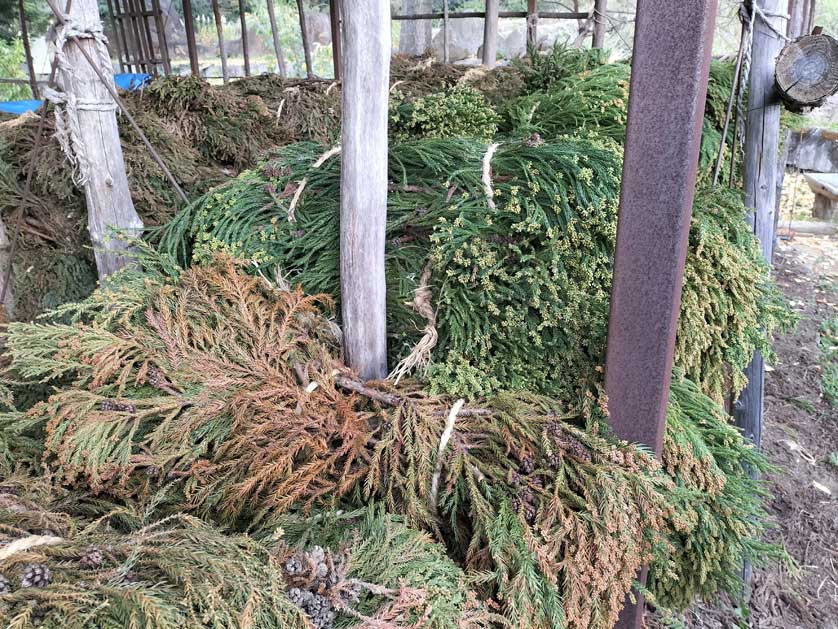Ibaraki Suisha Senkou Incense 水車線香
 |
| Buy incense from Ibaraki Prefecture |
Incense has a long history in Japan. Ritually smoldered for its fragrance in India and China since the most ancient of times, incense was introduced to Japan in the 6th century, along with Buddhism. Incense quickly caught on at the Japanese Imperial Court. By the time of the Heian Period (794 - 1185), incense had become a vital part of life at the court. People celebrated its fragrance, people wrote poems about the beauty of the aroma. Ancient woodprint images show people gathering in the gardens of the court, enjoying the pleasure of the smells while holding poetic parties.
Samurai culture adopted incense. Warriors purified their minds and bodies with incense before heading into battle.
 |
| Waterwheel at Komamura Seimeido |
Kodo 香道
In the 16th century, a century of much turmoil and many wars, a ceremony known as kodo (the Way of Incense) developed, alongside other by now classical Japanese ceremonies like the Tea Ceremony and Ikebana (flower arrangement).
Kodo was (and is) as strictly regimented as the Tea Ceremony with its very own set of tools and rules.
However, Kodo never caught on with the public the way the Tea Ceremony and Ikebana did.
For a very simple reason: the incense used at the Imperial Court and by the upper samurai had always been made from agarwood and / or sandalwood. Those fragrant woods had to be imported from South-East Asia or even India via China and Korea. They were incredibly expensive and only the Imperial Court, the richest of the temples and the richest of the samurai could afford real kotoboku, the most precious high-grade incense.
Buddhism had however spread all over the country, Buddhist ceremonies had become a part of daily life. All those many temples needed incense for their regular ceremonies - and they were in no position to acquire the agarwood the Imperial Court used. Thus, they turned to local sources. Cedar, lavender and other home-grown fragrant leaves and plants became the base of their incense.
 |
| Mt Tsukuba, Ibaraki Prefecture |
Incense Today
Today, incense is still an integral part of any Buddhist ceremony. But more and more frequently, people use incense without any religious connotation.
They use incense sticks to clean their homes from other smells, they use them to enjoy the fragrance, or perhaps to enhance the olfactory environs when being with a partner in a romantic night. The latter being quite in accordance with the use of the fragrance in Heian times.
Walking into any Japanese supermarket or drug store presents you with a variety of incense made by major manufacturers.
But as always, there are the mass-produced products and there are the ones that have their own distinct fragrance, that have their own history, their own story.
 |
| The traditional waterwheel at Komamura Seimeido |
Suisha Senkou 水車線香
Suisha Senkou is the brand name of the incense made at the small family-run Komamura Seimeido factory deep in the countryside outside of Ishioka, Ibaraki Prefecture. Cedar leaf incense is the main product of the facility though other types of incense are manufactured as well.
Suisha Senkou translates to "waterwheel incense" and indeed, an ancient watermill plays an important part in the production process.
Located at the foot of Mount Tsukuba, the Komamura Seimeido is surrounded by forests and rice paddies. A very quiet area in central Ibaraki. Not really that remote from Tokyo (you can easily go there on a day trip from the city), but far away enough to be able to stroll through the rice paddies and seeing nothing but an open sky above the landscape. No high-voltage powerlines in view at all.
Right behind the small Komamura Seimeido family farm house compound, a clear little mountain stream flows by. Coming down from Mount Tsukuba, the stream flows at a pretty good speed.
That mountain stream powers an ancient waterwheel which in turn powers the mill that slowly but steadily pounds the cedar leaves used as the base of the incense sticks. The slow, water-driven pounding process brings out the full aroma of the leaves.
The Komamura Seimeido uses the ancient watermill for exactly this reason. It has been doing so for more than 100 years by now.
All ingredients, most importantly the cedar leaves are local, no chemical agents, no glue is added at all.
One small building houses the processing factory. The machines there look pretty vintage as well but are clearly from the later part of the 20th century, running on electricity.
 |
| The water-powered mill |
There, the cedar powder is turned into a hot mash which then gets pressed into thin sheets. Those sheets are immediately mechanically cut the size of incense sticks.
After a period of drying, they are wrapped up into packages ready for sale.
If you make an appointment, the master of the house will show you all the details of production himself, he will answer all your questions, and you will be able to burn a few incense sticks of various kinds to make an educated choice of what to purchase.
 |
| Cedar leaves ready for processing |
Incense Variety
While cedar leaf incense is the main product, locally grown Tsukuba lavender, mikan (mandarin orange) peel and chrysanthemum incense are also manufactured and ready for purchase.
While a trip to the Ibaraki countryside and a visit to the Komamura Seimeido is certainly a pleasure, you can also purchase Komamura Seimeido Suisha Senkou also conveniently from Goods from Japan.
 |
| Ishioka incense |
Buy Incense From Japan
Goods from Japan offers a variety of Japanese incense.
Purchase a range of Japanese incense from GoodsFromJapan.
 |
| A worker at the press and cutting machine |
Related
Aizuwakamatsu Hand Painted Candles
by Johannes Schonherr
 |
| Vintage Komamura Seimedo Sign |
© GoodsFromJapan.com

